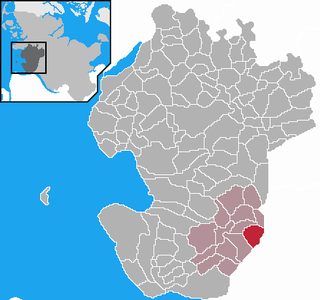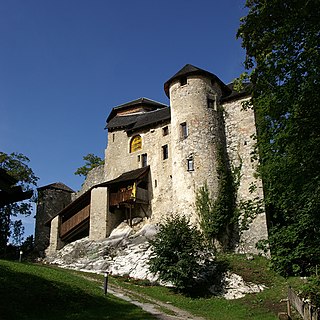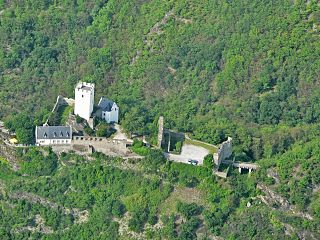
Cardiff Castle is a medieval castle and Victorian Gothic revival mansion located in the city centre of Cardiff, Wales. The original motte and bailey castle was built in the late 11th century by Norman invaders on top of a 3rd-century Roman fort. The castle was commissioned either by William the Conqueror or by Robert Fitzhamon, and formed the heart of the medieval town of Cardiff and the Marcher Lord territory of Glamorgan. In the 12th century the castle began to be rebuilt in stone, probably by Robert of Gloucester, with a shell keep and substantial defensive walls being erected. Further work was conducted by the 6th Earl of Gloucester in the second half of the 13th century. Cardiff Castle was repeatedly involved in the conflicts between the Anglo-Normans and the Welsh, being attacked several times in the 12th century, and stormed in 1404 during the revolt of Owain Glyndŵr.

Borculo is a city in the eastern Netherlands, in the municipality of Berkelland, Gelderland. Borculo was an independent municipality until 2005, when it merged with Eibergen, Neede, and Ruurlo. Other population centers in the municipality of Borculo were nearby Geesteren, Gelselaar, and Haarlo.

Castell Coch is a 19th-century Gothic Revival castle built above the village of Tongwynlais in South Wales. The first castle on the site was built by the Normans after 1081 to protect the newly conquered town of Cardiff and control the route along the Taff Gorge. Abandoned shortly afterwards, the castle's earth motte was reused by Gilbert de Clare as the basis for a new stone fortification, which he built between 1267 and 1277 to control his freshly annexed Welsh lands. This castle may have been destroyed in the native Welsh rebellion of 1314. In 1760, the castle ruins were acquired by John Stuart, 3rd Earl of Bute, as part of a marriage settlement that brought the family vast estates in South Wales.

White Castle is an American regional hamburger restaurant chain with about 350 locations across 13 states, with its greatest presence in the Midwest and New York metropolitan area. Founded on September 13, 1921, in Wichita, Kansas, it has been generally credited as the world's first fast-food hamburger chain. It is known for its small, square hamburgers referred to as "sliders". The burgers were initially priced at five cents until 1929 and remained at 10 cents until 1949. In the 1940s, White Castle periodically ran promotional ads in local newspapers which contained coupons offering five burgers for ten cents, takeout only. In 2014, Time named the White Castle slider "The Most Influential Burger of All Time".

Blankenstein Castle is a castle located on the south side of the river Ruhr in Hattingen, North Rhine-Westphalia, Germany.

A battery tower was a defensive tower built into the outermost defences of many castles, usually in the 16th century or later, after the advent of firearms. Its name is derived from the word battery, a group of several cannon.

Burg is a municipality in the district of Dithmarschen, in Schleswig-Holstein, Germany. It lies at the rim of the Heide-Itzehoe Geest with parts of the village in the marshland below. It was named after a fortress "Bökelnburg" of which a 9th-century earth wall ring remains. According to legend Burg was the site of a farmer's revolt. They burned down the castle and killed the count who had asked for a "tenth" tribute despite it being a time of drought.

The Animal Wall is a sculptured wall depicting 15 animals in the Castle Quarter of the city centre of Cardiff, Wales. It stands to the west of the entrance to Cardiff Castle, having been moved from its original position in front of the castle in the early 1930s. The design for the wall was conceived by William Burges, architect to the third Marquess of Bute, during Burges's reconstruction of the castle in the 1860s, but it was not executed until the late 1880s/early 1890s. This work, which included the original nine animal sculptures, all undertaken by Burges's favourite sculptor, Thomas Nicholls, was carried out under the direction of William Frame, who had previously assisted Burges at both Cardiff Castle and Castell Coch. When the wall was moved in the early 20th century, the fourth Marquess commissioned Alexander Carrick to carve a further six sculptures to sit on the extended wall which now fronted Bute Park. The Animal Wall is a Grade I listed structure.

Neu-Ems Castle is a medieval castle in Hohenems in the province of Vorarlberg, Austria. It was the fortification of the nobility Herren von Ems. Neu-Ems Castle is 666 metres (2,185 ft) above sea level.

Landskron Castle is a medieval hill castle northeast of Villach in the state of Carinthia, Austria. Dating to the early 14th century, the castle ruins are located on a rock cone of the Ossiach Tauern range, at an elevation of 658 metres (2,159 ft) above sea level. Today Landskron Castle, its falconry centre conducting regular flying demonstrations, and the nearby macaque enclosure are major tourist destinations.

Burgruine Ras is a ruined castle in Carinthia, Austria. It was first documented in 1171. Only the remnants of an encompassing wall and two round towers are present today.

Burg Greifenstein is a castle in Lower Austria, Austria, overlooking the Danube. Burg Greifenstein is 227 metres (745 ft) above sea level. Approximately opposite to Burg Greifenstein is Burg Kreuzenstein, on the north shore of the Danube.

Burg Kreuzenstein is a castle near Leobendorf in Lower Austria, Austria. Burg Kreuzenstein is 265 metres (869 ft) above sea level. It was constructed on the remains of a medieval castle that had fallen into disrepair and was then demolished during the Thirty Years' War. Intended to be a family vault for the Wilczek family, it was rebuilt in the 19th century by Count Nepomuk Wilczek with money from the family's large Silesian coal mines. Kreuzenstein is interesting in that it was constructed out of sections of medieval structures purchased by the family from all over Europe to form an authentic-looking castle. Thus, the castle can be considered both a 'neo-' and 'original' medieval structure. The castle is sometimes used as a location for films, for example in Baron Blood, directed by Mario Bava in 1972.

Burg Perchtoldsdorf is a castle in Lower Austria, Austria. Burg Perchtoldsdorf is 261 metres (856 ft) above sea level.

Burg Raabs an der Thaya is a castle in municipality Raabs an der Thaya, Lower Austria, Austria, built in the second half of the 11th century, it is 456 metres (1,496 ft) above sea level.

Hohenwang is a ruined castle in Municipality of Langenwang, Styria, Austria. It stands on a hill at an elevation of 650 metres above sea level.

Burg Krems is a castle in Styria, Austria. Burg Krems is 330 metres (1,080 ft) above sea level.

Burg Neuhaus bei Stubenberg is a renovated castle ruin in Stubenberg, Styria. It is located above the ravine of the Feistritz river named Stubenbergklamm .

Münzenberg Castle is a ruined hill castle in the town of the same name in the Wetteraukreis, Hesse, Germany. It dates from the 12th century. It is one of the best preserved castles from the High Middle Ages in Germany.

Sterrenberg Castle is a castle above the village of Kamp-Bornhofen in Rhineland-Palatinate, Germany.






















